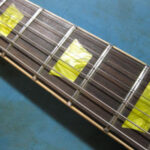When beholding iconic images of The Beatles, certain guitars instantly come to mind: John Lennon’s Rickenbacker, George Harrison’s Gretsch Country Gentleman, and Paul McCartney’s Hofner bass. These instruments are as much a part of the band’s visual identity as their mop-top haircuts and sharp suits. For guitar enthusiasts, delving into the Beatles’ guitar choices is endlessly fascinating, revealing a layer of their musical personality. While none of the Fab Four are widely known for playing an ES-335 guitar, there’s a compelling, lesser-known story involving George Harrison and a close relative of this iconic instrument: the ES-345.
During the peak of Beatlemania in the mid-1960s, the guitars wielded by John, Paul, and George were objects of intense scrutiny and desire for aspiring musicians worldwide. The Ed Sullivan Show performance in February 1964 ignited a global guitar craze, with young viewers eagerly trying to identify the instruments their idols played. While Rickenbacker and Gretsch became household names thanks to the Beatles, the ES-335 and its variations, though not prominently featured, have their own intriguing connection to the band’s history.
While the Beatles primarily favored instruments like Epiphone Casinos – semi-hollow guitars similar in construction to the ES-335 family but often considered less high-end – there was a brief but significant period when George Harrison embraced an ES-345. The Epiphone Casinos, much like Gibson ES-330s, were known for their feedback potential at high volumes. For a stadium-filling band like the Beatles, controlling feedback was crucial, except perhaps for intentional moments like the intro to “I Feel Fine.”
Interestingly, during the same mid-to-late 60s period when the Beatles were shaping music history, many guitarists were gravitating towards guitars in the ES family. The author of the original article even mentions owning a ’63 ES-330, highlighting the widespread appeal of these semi-hollow designs. However, it’s George Harrison’s foray into the ES-345, the more upscale sibling of the ES-335, that truly captures attention.
George Harrison acquired a sunburst stoptail ES-345 in 1965 and quickly integrated it into his stage setup, starting in November of that year. This ES-345 became his main stage guitar after a mishap involving his second Gretsch Country Gentleman and a truck during their 1965 tour. Based on its features, the 345 appears to be a late 1963 or 1964 model. It was not uncommon for high-end guitars, especially in the UK, to be purchased a year or two after their production date.
The Beatles’ final British tour in December 1965 saw George Harrison initially using his second Gretsch Country Gentleman. However, after the unfortunate “lorry” incident, the ES-345 stepped into the spotlight. For the remainder of the tour, Harrison played the ES-345 alongside his Rickenbacker 12-string, marking a unique chapter in Beatles guitar history.
Despite its brief but significant use during this pivotal tour, George Harrison’s ES-345 seemingly vanished after the tour concluded around Christmas 1965. Its whereabouts remain unknown, fueling speculation among Beatles and guitar aficionados. The author of the original article playfully muses about whether this very guitar might have passed through his hands at some point, adding to the mystique surrounding this “Beatle guitar” that is not a Casino, not a Gretsch, and not a Rickenbacker.
The ES-345 itself is a fascinating guitar, often considered a more luxurious version of the ES-335. Known for its semi-hollow body construction, which provides a blend of warmth and sustain, the ES-345 also typically featured a Varitone switch – a feature that George Harrison himself, in a humorous caption, seemed to appreciate on his instrument. This circuit offered a range of tonal colors, although some players felt it could also slightly reduce the guitar’s pure tone. Regardless, George Harrison’s use of the ES-345 underscores the versatility and appeal of the ES-335 family of guitars, even for artists primarily associated with other iconic instruments.
While George Harrison’s main guitars remain etched in popular memory, the story of his ES-345 offers a unique glimpse into a lesser-known chapter of Beatles history and their relationship with guitars beyond the usual suspects. It reminds us that even the most iconic musicians explore different instruments, and that the ES-335 family, including the ES-345, holds a special place in the broader narrative of rock and roll guitar history. The mystery of what became of George’s ES-345 only adds to its allure, making it a captivating footnote in the story of the Beatles and the guitars that shaped their legendary sound.

